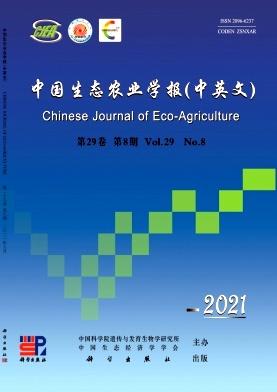Ecological evaluation and reconstruction of fine-scale rural landscape: Ecological evaluation and reconstruction of fine-scale rural landscape
Q3 Agricultural and Biological Sciences
引用次数: 2
Abstract
Strong demands for rural landscape development have taken into account of environmental issues related to sustainable development. The objective of this paper was to evaluate the main ecological effects of fine-scale rural landscape construction projects. Local landscapes boundaries,land uses and attributes were identified in a field survey with the help of high-resolution satellite images. Landscapes with least edge length over 2 m were classes as patches. These landscapes contained eight land use types,including farmlands,orchards,forests,grass,construction lands,roads,waters and others. Landscapes with least edge length between0.5 m and 2 m were classed as linear landscapes. Such landscapes included vegetations,field roads,field ridges and ditches. All the field survey data were digitalized into a database in ArcGIS. Evaluation of landscape patterns and attributes was based on the rural landscape database composed of patches and linear landscapes. Landscape attributes contained land pavement and vegetation.Vegetation improvement potential was analyzed in three scenario conditions — basic,standard and optimal scenarios. Case studies were conducted in Daxing Region of Beijing City,Quzhou County of Hebei Province and Changshu City of Jiangsu Province. The study showed that current rural landscape construction projects seldom considered environment issues and had caused negative effects on landscape patterns and attributes. Simple block landscape patterns built in rural landscape construction projects eliminated landscape characteristics among different regions,forming similar landscapes in different areas. Field roads,ditches and field ridges were important linear landscapes with high densities in all three areas. Management patterns of shelterbelts were bad as interval distances between main shelterbelts were always larger than required optimal length for wind prevention. Over use of impervious surface pavements was a critical environmental risk in rural infrastructure construction. This risk was more serious in rural areas with strong economic support than in areas with weak economic investment. Excessive impervious surface pavements such as roads had reached 28.46% and 56.19% in Daxing Region and Changshu City,respectively,while it was only 5.6% in Quzhou County. Based on the evaluation of wood-cover and live vegetation volume,linear shelterbelt was nearly as importance as wood-plots at the local scale.Shelterbelts faced risks of simple vegetation structure,low tree species diversity and missing shelterbelt in range of 18% 38%.Simulation of the basic,standard and optimal scenarios showed a large potential for the improvement of wood-cover and live vegetation volume in rural areas through planting linear vegetation. Land use pressure was not simulated for linear vegetation distributions in marginal lands along roads,ditches and river banks. Through legitimate and appropriate planning and construction,wood-cover potentially increased by 0.58% 1.16% while live vegetation volume increased by 2.22% 19.59% under the standard scenario. Furthermore,the optimal scenario had higher growth of wood-cover and live vegetation volume. It was important to pay more attention to linear vegetation,including shelterbelt,in rural landscape planning for purpose of ecological improvement. The study revealed that evaluation at local scale was efficient in quantitatively identifying the shortcomings of current local landscape in terms of ecological conservation.精细尺度乡村景观的生态评价与重构:精细尺度乡村景观的生态评价与重构
对农村景观发展的强烈要求已考虑到与可持续发展有关的环境问题。本文的目的是评价小规模乡村景观建设项目的主要生态效应。在高分辨率卫星图像的帮助下,实地调查确定了当地景观边界、土地用途和属性。最小边缘长度大于2 m的景观被归类为斑块。这些景观包含8种土地利用类型,包括农田、果园、森林、草地、建设用地、道路、水域等。最小边缘长度在0.5 ~ 2 m之间的景观为线性景观。这些景观包括植被、田间道路、田间山脊和沟渠。所有的野外调查数据都在ArcGIS中数字化进入数据库。基于斑块和线性景观组成的乡村景观数据库进行景观格局和属性评价。景观属性包括土地路面和植被。分析了基本情景、标准情景和最优情景下植被改善潜力。案例研究分别在北京市大兴区、河北省衢州市和江苏省常熟市进行。研究表明,当前乡村景观建设项目很少考虑环境问题,对景观格局和景观属性造成了负面影响。乡村景观建设项目中构建的简单块状景观格局消除了不同区域之间的景观特征,形成了不同区域的相似景观。田间道路、沟渠和田埂是重要的线性景观,在这三个区域都具有较高的密度。主要防护林之间的间距总是大于所需的最佳防风长度,防护林的管理模式很差。在农村基础设施建设中,过度使用不透水路面是一个重要的环境风险。这种风险在经济支持较强的农村地区比在经济投资较弱的地区更为严重。大兴地区和常熟市道路等不透水路面超限比例分别达到28.46%和56.19%,而衢州市仅为5.6%。基于对木盖度和活植被体积的评价,在局地尺度上,线性防护林的重要性几乎与林地同等重要。18% ~ 38%的林带面临植被结构简单、树种多样性低和林带缺失的风险。对基本、标准和最优情景的模拟表明,通过种植线性植被,农村地区的木盖度和活植被量有很大的改善潜力。在沿道路、沟渠和河岸的边缘土地上,没有模拟线性植被分布的土地利用压力。通过合理合理的规划建设,在标准情景下,木盖度潜在增长0.58%(1.16%),活植被体积增长2.22%(19.59%)。此外,最优方案具有较高的木盖度和活植被体积增长量。在农村景观规划中,应重视包括林荫带在内的线性植被,以达到改善生态环境的目的。研究结果显示,在地方尺度上进行评估,可以有效地定量识别当前当地景观在生态保护方面的不足。
本文章由计算机程序翻译,如有差异,请以英文原文为准。
求助全文
约1分钟内获得全文
求助全文
来源期刊

Chinese Journal of Eco-agriculture
Environmental Science-Ecology
CiteScore
2.70
自引率
0.00%
发文量
0
 求助内容:
求助内容: 应助结果提醒方式:
应助结果提醒方式:


